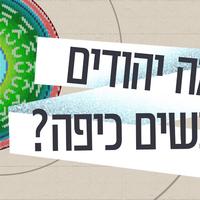כאן סקרנים | למה יהודים חובשים כיפה?
Here are curious Why do Jews wear a kippah?
אברהם אבינו לא הלך איתה, הגאון מווילנה יצא נגדה
Avraham Avinu didn't wear one, the Vilna Gaon was against wearing it
ובאירופה היא בכלל התחילה כסמל אנטישמי.
and in Europe it started as an antisemitic symbol.
אז למה יהודים חובשים כיפה?
So why do Jews wear Kippot?
שלא כמו רוב המנהגים הדתיים המוכרים לנו,
Unlike most of the religious customs we're familiar with,
כמו ברית מילה או שמירת שבת,
like circumcision or keeping shabbat,
כיסוי הראש הוא מנהג שצמח 'מלמטה'.
covering one's head is a custom that grew "from below".
בתנ"ך כמעט לא מוזכרת החובה לכסות את הראש.
In the old testament almost never mentions the necessity to cover one's head.
רק הכוהנים בבית המקדש, שחבשו מצנפת.
Only the priests in the Beit HaMikdash (The Holy Temple) who wore turbans.
גם אחד מחכמי הגמרא, הרב הונא,
Also one of the sages of the Gemara, Rav Huna,
העיד על עצמו שהוא תמיד מכסה את הראש כי הוא ירא שמיים במיוחד.
who put it upon himself to always have his head covered because he was especially fearful of God.
ולמה כיסוי ראש קשור ליראת שמיים? אולי בגלל הרומאים.
And why is covering your head connected to fear of God? Maybe because of the Romans.
באותה תקופה עבדים ברומא הלכו עם כיסוי ראש
In the same period, servants in wore head coverings
ואנשים חופשיים - בלי.
and free people- didn't.
רב הונא כאילו אמר על עצמו "אני עבד" של ה',
Rav Huna seemed to be saying "I'm a servant of God."
אבל הוא היה יוצא דופן.
but he was unusual.
פסיפסים מתקופות קדומות מציגים דמויות יהודיות חשובות בראש מגולה,
Mosaics from earlier periods present important Jewish figures in their heads uncovered,
כמו עזרא הסופר, למשל.
like Ezra the Scribe for example.
בתקופת הגאונים במאה השמינית, נפסק להלכה
During the period of the Geonim in the eighth century, it was halachically (by Jewish law) ruled
שאסור להזכיר את שם ה' ללא כיסוי ראש,
that you couldn't cite Gods name without a head covering,
מה שהגביל את החובה לתחומי בית הכנסת או לתלמידי החכמים,
which limited the obligation to the areas of the synagogue or to the scholars,
שעוסקים כל היום בתורה.
who are occupied with Torah all day.
במאות הבאות העולם היהודי התפצל: בארצות מוסלמיות
In the next few centuries, the Jewish world was split.
כולם, גם לא יהודים, הלכו בכיסוי ראש.
Everyone, not even Jews, went head to head.
ללכת בלי היה... מוזר.
To go around without one was strange.
בארצות אירופה, לעומת זאת כמעט אף אחד לא הלך עם כובע
In contrast to this, in European countries almost nobody walked around in a hat
חוץ מאשר בעלי תפקידים.
excluding officials.
האפיפיור, למשל, הלך עם כיפה בשם "זוקטו" או דלעת, בעברית.
The pope for example, wore a skullcap called "Zucchetto" or "Dlaat" (a pumpkin') in Hebrew.
בטקסים חשובים במיוחד היה אפילו נהוג להסיר את הכיפה,
In especially important ceremonies it was customary to remove the skullcap
ומכאן הביטוי 'להוריד בפניו את הכובע', כסמל של כבוד.
thus creating the expression "Taking one's hat off" as a symbol of respect.
כאן נכנסת לתמונה ידידתנו הוותיקה - האנטישמיות.
Here, our ancient friend comes into the picture- antisemitism.
בתחילת המאה ה-13 הכנסייה הקתולית החליטה לסמן את היהודים.
In the beginning of the 13th century the catholic church decided to mark Jews.
דרך יעילה הייתה באמצעות 'כובע היהודים',
An innovative way to do this was by introducing the "Jewish Hat"
כיסוי ראש בעל צורה מגוּחכת.
a hat with a ridiculous shape.
אבל במקום להרגיש מושפלים,
But instead of feeling humiliated,
היהודים לקחו את הכובע למקום של גאווה והשתייכות קהילתית
Jews took this hat to a place of pride and community belonging
וכיסוי הראש הפך יותר ויותר נפוץ.
and head coverings became more and more common.
הוא אפילו נכנס להגדה העתיקה ביותר שיש לנו, הגדת הציפורים.
It even got into our oldest Haggadah, the Bird's Head Haggadah.
אגב, אותו כובע בדיוק הפך לסמל כללי לדמויות בעייתיות
By the way, this same hat turned into a general symbol of problematic characters
כמו עבריינים, גמדים ומכשפות,
such a criminals, dwarfs and witches,
וכך התגלגל גם ל'כובע הקוסמים' המוכר לנו.
and thus became known as the "Witch hat" that we know today.
באמצע המאה ה-16 זה הפך לרשמי,
In the middle of the 16th century it became official,
רבי יוסף קארו פרסם את הטקסטבוק של היהדות, ה'שולחן ערוך',
Rabbi Yosef Karo published the textbook on Judaism, the Shulchan Aruch.
וקבע את הסטנדרט: "לא ילך ארבע אמות בגילוי הראש".
and set the standard of: One will not go more than four cubits bareheaded".
למה? משלוש סיבות:
Why? For 3 reasons:
"משום שהשכינה שורה מעל לראשו", משום חוקות הגויים,
"Because the divine presence rests upon his head", from the laws of the gentiles,
כלומר, כדי להפריד בין יהודים ללא יהודים
in other words, in order to differentiate Jews and non-Jews
או כדי להינצל מ'רוחות רעות'.
or to save oneself from "bad spirits".
ועדיין, חובת כיסוי הראש לא נטמעה לגמרי.
Yet still, the obligation to cover one's head was not entirely assimilated.
הגאון מווילנה, למשל, כתב במאה ה-18
In the 18th century for example, the Vilna Gaon wrote
ש"אין איסור כלל בראש מגולה לעולם".
that there is no prohibition whatsoever of an exposed head.
אבל במאה הבאה כיסוי הראש קיבל דחיפה רצינית בשתי תפוצות.
But in the next century head covering had a serious push in 2 diasporas.
ברוסיה, הצאר ניקולאי הראשון הטיל מגבלות קשות על כיסוי הראש,
In Russia, the tsar Nicholas I imposed severe restrictions on head coverings.
בחורי ישיבה הותקפו, פאותיהם קוצצו וכֿיסוי הראש שלהם הוחרם.
Yeshiva boys were assaulted, their sideburns were cut and their head coverings were banned.
חבישת כיסוי ראש יהודי הפכה ל'מסירות נפש',
The wearing of a Jewish head covering became a sign of faithfulness,
מעשה שמעיד על דבקות דתית.
an act that attests to religious devotion.
במקביל, בארה"ב, חבר הנאמנים של 'טמפל עמנואל' הרפורמי בניו יורק
At the same time in the United Sates, the board of trustees of the reform synagogue "Temple Emanu-El" in New York
החליט שכמו בכנסייה בטקסים בטמפל המתפללים יסירו את כיסוי הראש,
decided that like in a church at temple ceremonies, the worshipers would remove their head coverings,
ואם כך עושים הרפורמים, האורתודוקסים יעשו את ההפך.
and if this is what the Reform did, the Orthodox did the exact opposite.
במהלך המאה ה-19 מתחת לכיסוי הראש, הכובע או הטורבן,
During the 19th century under the head covering, a hat or the turban,
התחילו להופיע כיפות.
Kippot started appearing.
בצילומים מתימן אפשר למצוא כיפות לבד ככיסוי ראש פשוט,
In photographs from Yemen you can find Kippot alone as a simple head covering.
ובאירופה הכיפה היא חתיכת בד שחובשים בבית במקום הכובע,
and in Europe, the Kippah was a piece of cloth that was worn at home instead of a hat,
שמתאים יותר לַהליכה בחוץ.
that's more appropriate for going outside.
אבל במהלך המאה ה-20 פחות ופחות אנשים חבשו כובע.
But during the 20th century fewer and people wore hats.
החלוצים הסוציאליסטים בארץ ישראל ראו בכובע סמל של בורגנות
The socialist pioneers in Israel saw the hat as a symbol of bourgeoisie
והלכו לכל היותר בכאפייה או בכובע טמבל.
And at most a kaffiyeh or a tembel hat.
ולא רק החלוצים, זה היה תהליך עולמי.
And not just the pioneers, this was a worldwide trend.
אחרי מלחמת העולם השנייה החלו אנשים לעבוד בבית חרושת או במשרד,
After WWII people started working in factories and offices,
ולא נזקקו להגנה שהכובע סיפק ממזג האוויר.
and did not need to the protection from weather conditions that the hat offered.
באותה תקופה גם נכנסו לשימוש קרם ההגנה ומשקפי השמש
In the same period sunscreen and sunglasses also came into use
והמכוניות הפרטיות הפכו נפוצות.
and private automobiles became common.
ניסיתם פעם להיכנס לִמכונית עם כובע?
Have you tried getting into a car with a hat on?
וכשירד הכובע, נשארה הכיפה.
And when the hat came off, the Kippah stayed.
אבל אז מתרחש פיצול.
But then a schism occurred.
הרב משה צבי נריה שהקים את ישיבת בני עקיבא הראשונה בכפר הרא"ה
Rav Moshe-Tzvi Neria established the first Bnei Akiva yeshiva in Kfar Haroeh,
הבחין שחלק מהתלמידים מתביישים בכיפה השחורה
realized that some of the students were embarrassed of the black kippah
ומנסים שהיא 'תיבלע' בשיער.
and tried to hide them in their hair,
בביקור באחד הקיבוצים הדתיים הוא ראה בחורה
In one visit one of the religious kibbutzes she saw a girl
שסרגה כיפות דרום אמריקניות צבעוניות והחליט:
knitting colorful south american kippot and decided:
את הכיפה הזאת אי אפשר להסתיר. זו תהיה הכיפה שחובשים בישיבה.
This kippah cannot be hidden. This will be the kippah that is worn in yeshiva (a Jewish learning institution).
'קמפיין הלא מתנצלים', גרסת 1939.
'Campaign not apologizing' occurred in 1939.
20 שנה לאחר מכן בסוף שנות ה-50', 'דור הכיפות הסרוגות'
20 years later at the end of the 1950's, 'The Knited Kippah Generation'
כבר הייתה סיסמת הבחירות של המפלגה הדתית לאומית.
was already the slogan of the National Religious Party.
מאז, סוג הכיפה מעיד על המגזר שאליו האדם שייך:
From then on, the kippah pertained which sect a person was affiliated with:
סרוגה - דתי לאומי. שחורה - חרדי.
Knitted- Religious Zionist. Black- Haredi
עם השנים נוצרו שלל כיפות 'על הרצף'
with the years a whole range of kippot were created
שכל אחת מהן מציינת את ההשתייכות החברתית המדויקת
with each one of them signifying a persons exact social affiliation
של מי שחובש אותה.
of whoever wore it.
רק החרדים האשכנזים - נשארו עם הכובע.
only the Askenazi Haredi sect kept wearing the hat.
והסיכה? את סיכת ההידוק המוכרת לנו
And the clip? The snap clip which we all know
המציאו בשנת 1957 אב ובן אמריקנים בשם אדוארד פ' צור,
was invented in 1957 by an American father and son named Edward Patzer
והיא החליפה את הסיכה הפשוטה.
and it replaced the simple clip
הנוחות של סיכת ההידוק - הפכה אותה ללהיט.
The convenience of the snap clip turned it into a complete hit.
כמעט אין ראש דתי בלעדיה
There is almost no religious head without it.
וּשלל השימושים שהיא מאפשרת הצמידו לה את הכינוי 'לדרדוס'.
And the many functions that it allows lent it the name "Leatherdos".
סטודנט לעיצוב תעשייתי, יעקב גולדברג שמו,
A student of industrial design, Yaakov Goldberg,
אפילו יצר סיכת ראש משודרגת עם פותחן, סרגל וגם... פצירה.
even created an upgraded hair clip with a bottle opener, a ruler and ... a nail file.

